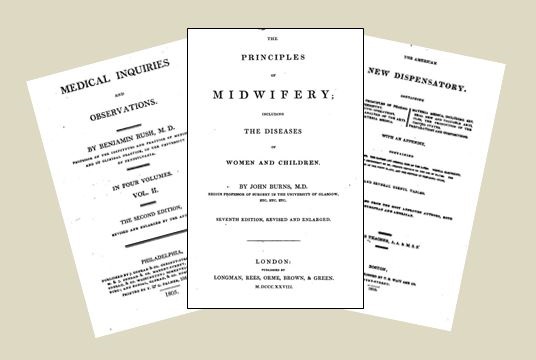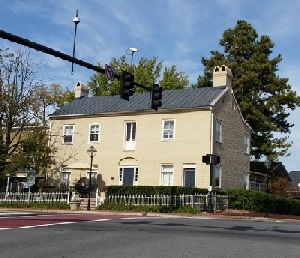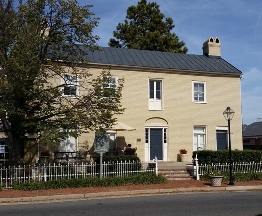| Dr. Draper's House and Apothecary Shop At Fairfax Court House, Town of Providence |
|
by Debbie Robison November 8, 2015 |
|
In 1821 Dr. Simeon Draper built a large, federal-style brick residence
at the east end of the Town of Providence (now Fairfax City) on a quarter-acre
lot.[1]
Funds to build the house were obtained from Catherine Draper's mother, Lucretia Wilkinson, who loaned Dr. Draper $1,000 worth of stock in the Potomac Bank of Alexandria to be sold to raise the funds. Lucretia Wilkinson acquired the money by selling her dower interest in land located in Prince William County. Many in the family encouraged Mrs. Wilkinson to loan the money, including Robert Ratcliffe. Lucritia Wilkinson and Juliet Wilkinson, Catherine's sister, lived with the Drapers for a time soon after the house was built.[6b] Dr. Draper also leased Lot 13, a half-acre corner lot on the south side of Fairfax Street (the portion of the Little River Turnpike that passed through the town).[7] This is probably where Dr. Draper operated his apothecary shop. On his shelves could be found a caster of Lima barks (quinine to treat malaria), a pot of Mercurial Ointment (to treat syphilis), a jug of castor oil (a purgative), a keg of white lead (a salve), medical roots, Venice turpentine, and Venetian Red. The last two items could be used to make bottle sealing wax.[8] Medicine was also stored in a chest of drawers.[9]
Demijohn, a Wicker Covered Glass Bottle Graduated Measure Mortar and Pestle His shop contained apparatus for preparing medicines, including a marble mortar, pestle, and slab; a glass mortar and pestle; an iron mortar; a graduated measure; two spatulas; a cork screw; and two pairs of scales with weights. Pharmacological information was available from Thatcher’s Dispensatory and Ellis’s Formula, two of the many books in Dr. Draper’s extensive medical library. At his death, Dr. Draper’s shop contained 110 decanters, phials, bottles, and jars; 8 jugs; and numerous demijohns containing medicine.[10] The volumes of books in his medical library included the Medical Recorder, 6 vols.; Parr’s Medical Dictionary, 2 vols.; Rush’s Medical Inquires, 2 vols.; Cullin’s Practice, 4 vols.; Chapman’s Therapeutics, 2 vols.; Fyfe’s Anatomy, 2 vols.; Hunter and Carmichael on Venivial; Murray and Bastow’s Materia Medica; Bell on Love’s Venivial, 2 vols.; Thomas’s Practice; Ellis’s Formula; Bell’s Surgery; Burn’s Midwifery; Phillip and Halstead on Indigestion; Richards Physiology; Thatcher’s Dispensatory; Hooper’s Medical Dictionary; Johnston on Liver; Eberley Materia Medica, 2 vols.; and many more.[11] 
Dr. Draper made house calls to perform the services of a physician and dentist. He had saddle bags in his shop, possibly for carrying medical equipment and medicines. His equipment consisted of surgical and dental instruments, including tooth drawers, and a surgical pocket book.[12] Charles Draper Williams, his nephew, came to live with the Draper family at the age of 18 and pursued a study of medicine under Dr. Draper’s tutelage. He went on to practice medicine in New York. His biography is provided in an 1873 encyclopedia of homoeopathic physicians and surgeons.[13] In 1832, Dr. Draper died at the age of 47 of Asiatic cholera in a short but severe illness.[14] A worldwide pandemic of Asiatic cholera was occurring at the time. The apothecary shop and supplies were sold to pay debts and the remaining estate, consisting of the dwelling house and personal property, were used by his widow.[15]
The 60th Regiment Virginia Militia officers met at her house in 1834 for a military meeting where they resolved to publish their opinions on “an act for the better organization of the Militia.”[20] In 1860, a correspondent to the Alexandria Gazette promoted Mrs. Draper’s establishment. The closing of the Union Hotel is much regretted by our citizens, but strangers and friends can find a bountiful table, pleasant rooms, and a quiet retreat at the house of Mrs. C. Draper, one or our oldest residents, who for twenty years has kept a house of private entertainment, gaining the good will of all who stopped with her, and receiving the Virginia “God bless you,” graciously given by friends, who faithfully have kept their promise “not to forget aunt Kitty.”- Alexandria Gazette, August 9, 1860[21] Encumbered with debt, Catherine Draper’s house and personal property were sold at auction in 1871 to her son-in-law, William R. Chapman, who continued to run the establishment.[22] Endnotes [1] Fairfax County Deed Book (FX DB) S1(45)268, April 14, 1821;Fairfax County Land Tax of 1822. [2] FX DB S1(45)268, April 14, 1821. [3] Fairfax County Land Taxes 1813-1837.Ratcliffe sold the eastern half of lot 8, eastern half of lot 10, lot 19, and the eastern half of lot 11. [4] Fairfax County Land Taxes 1813-1837.In 1822, Ratcliffe owned nine lots in Providence that included improvements, i.e. buildings. [5] FX DB S1(45)265, April 14, 1821. [6] Fairfax County Will Book (FX WB) L1(661)374, August 18, 1819. Guardian bond. [6b] Augusta County, Virgina chancery case 1829-049, Draver v. Grove, etc. [7] Fairfax County Chancery Case Moss v. Ratcliffe, cff 1843-023, as viewed online at Library of Virginia, Virginia Memory. Accounts indicate that Dr. Draper rented Lot 13 from 1825-1834. [8] Leonard’s Illustrated Medical Journal, Vol. 1, Detroit Michigan, 1880, p. 43, as viewed on Google Books. [9] FX WB R1(667)204, October 30, 1832, Simeon Draper estate inventory; FX WB R1(667)207, November 5, 1832, Simeon Draper estate sale. [10] FX WB R1(667)204, October 30, 1832, Simeon Draper estate inventory; FX WB R1(667)207, November 5, 1832, Simeon Draper estate sale. [11] FX WB R1(667)204, October 30, 1832, Simeon Draper estate inventory; FX WB R1(667)207, November 5, 1832, Simeon Draper estate sale. [12] FX WB R1(667)204, October 30, 1832, Simeon Draper estate inventory; FX WB R1(667)207, November 5, 1832, Simeon Draper estate sale. [13] Cleave, Egbert. Cleave's Biographical Cyclopaedia of Homeopathic Physicians and Surgeons. Galaxy Publishing Company, Philadelphia, 1873, as viewed on Google Books. [14] Alexandria Gazette, September 22, 1832, p. 3. Simeon Draper obituary. Also, Cleave, Egbert. Cleave's Biographical Cycloaedia of Homeopathic Physicians and Surgeons. Galaxy Publishing Company, Philadelphia, 1873, as viewed on Google Books. [15] Fairfax County Chancery Case Chapman v. Draper, cff 1879-010, as viewed online at Library of Virginia, Virginia Memory. [16] FX DB B3(54)336, January 28, 1835; FX DB G3(59)249, March 1842; FX DB H3(60)297, July 22, 1843; FX DB D4(82)43, January 28, 1861. [17] Alexandria Gazette, September 17, 1834, p. 3; Alexandria Gazette, August 9, 1860, p. 2; Alexandria Gazette, December 30, 1868, p. 4; Federal Census of 1860. [18] FX WB R1(667)207, November 5, 1832, FX DB B3(54)336, January 28, 1835. [19] FX DB H3(60):297, July 22, 1843; FX DB S4(97)428, November 24, 1874. [20] Alexandria Gazette, September 17, 1834, p. 3. [21] Alexandria Gazette, August 9, 1860, p. 2. [22] FX DB M4(91)256, March 20, 1871. |

| Home |
 |
| © Debbie Robison, unless otherwise noted. All rights reserved. |

